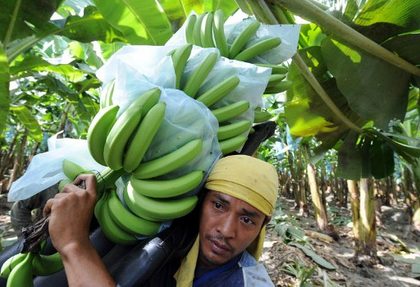SUMMARY
This is AI generated summarization, which may have errors. For context, always refer to the full article.

MANILA, Philippines [UPDATED] – Aside from sending a technical team from the agriculture department to persuade the Chinese government to reconsider a quarantine on banana exports from the Philippines, the Aquino government is also reminded of a pending issue: this banana-growing country needs to seek new markets.
On Monday, May 14, President Aquino told reporters in Davao City, where he was attending an event, that he has instructed — and reminded — government officials to look for alternative markets for Philippine exports.
“If we export 30% of our bananas to just one country — and that country has financial sanctions against them — we then have to ask ourselves where we will bring those export products that account for as much as 30% of total?” he said in Filipino.
“In some of these markets, our export products already account for as much as 90% to 100%. So even these established markets are already full of our banana exports. What we need to do now, and my instruction to them since last year, is to add to the list of countries that we are exporting to so we are not at the mercy of these countries,” he added.
The Philippines export around 200 million cases of banana products every year, according to Trade Secretary Gregory Domingo. Of this, around 50 million cases are exported to China, making it the second biggest market for Philippine banana next to Japan.
Technical, not geopolitical
Chinese authorities have refused the entry into China of some 150 containers containing Cavendish banana because of an alleged finding that fruits earlier sent by Mindanao banana growers there showed signs of disease found only in coconuts.
These trade-related issue cropped up as the Philippines and China are currently engaged in a bitter and almost two-month-long territorial standoff in Scarborough Shoal in the disputed West Philippine Sea (or South China Sea).
But the Aquino government is treating the banana exports issue as a technical issue than a territorial one.
Spokesperson Edwin Lacierda had said last week that “The concern over our banana exports to China is sanitary and phytosanitary issue, and the DA through the Bureau of Plant and Industry is addressing this with its counterpart agency for quarantine in China. DA, DTI, banana growers and the Philippine Embassy in China are coordinating on this matter. This is best addressed by the technical and regulatory agencies of both countries.”
“This is why the technical team would be flying to China to ascertain why the 43 batches of bananas were denied entry since last March,” Trade Secretary Domingo said on May 14.
Domingo said banana exports to China have slowed down because the ongoing inspections at the ports slow the processing of the fresh fruits.
Agriculture Secretary Proceso Alcala told reporters at the same Davao event on May 14 that a team from the Philippines is traveling to China to resolve this impasse.
“This week, we have a team that will go to China. They will bring their credentials so they will be there when our export products will be opened up,” Alcala said.
He added that this team will also extend an invitation to their Beijing counterparts to visit the Philippines. “We hope they (Chinese officials) will send a delegation to visit and check our protocols here. It’s important that we prove that these bananas are also exported to other countries, not just to China.”
“We are confident that this can be resolved, given that our banana exports passed the stringent measures in Japan,” Deputy Spokesperson Abigail Valte said in a radio interview on May 13.
Last week, Trade Secretary Domingo said representatives from the Department of Agriculture (DA), the Department of Trade and Industry (DTI), and Department of Foreign Affairs (DFA) are talking to their Beijing counterparts to resolve the issue.
Export markets
The lack of diversity in export markets has been a general and pending issue for decades.
The concentration of Philippine exports on a specific product — electronics — has long concerned officials. In 2008 and 2011, when the world economy faltered due to financial crisis in the west, Philippine exports suffered badly, pulling down the overall economic growth of the country.
Trade Secretary Domingo said that, in the case of banana exports, the Philippines is looking at other markets, too.
“The natural markets [are] the Middle East via Iran… [but] very little exports outside of Iran. It’s possible to tap into other Middle Easter markets. I have instructed [Trade Undersecretary Cristino] Panlilio to do investment missions there,” Domingo told reporters on May 12.
Aside from the banana-related trade dispute with China, the Philippines is also up against a travel advisory from China.
China is the 4th largest tourism market for the Philippines, which is upping its tourism arrival targets to double to 6 million by 2016.
These moves by China are seen as economic pressure on the Philippines due to the standoff between the two countries in Scarborough Shoal in the disputed West Philippine Sea (or South China Sea). – Rappler.com
Add a comment
How does this make you feel?
There are no comments yet. Add your comment to start the conversation.